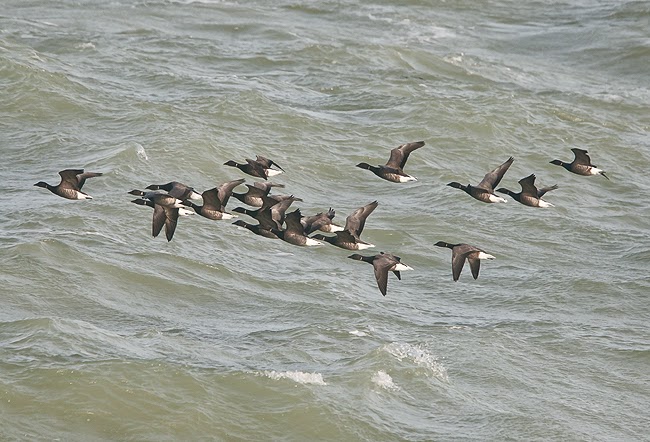Down in one!
08.00-10.15 from the fishing boats with DW, a much quieter watch from recent days.Brent Goose: 299 W 22 E
Shelduck: 2 W
Common Scoter: 32 W 27 E
Red-breated Merganser: 1 W
Red-throated Diver: 2 W
Gannet: c50 off shore
Turnstone: 15 around
Curlew: 1 over
Ringed Plover: 1 over
Great Skua: 3 E
Arctic Skua: 2 around
Mediterranean Gull: 6 around
Yellow-legged Gull: 1 ad on sea
Kittiwake: 85 around
Sandwich Tern: 4 W
Common Tern: 1 W
Guilemot: 2 around
Razorbill: 2 around
Auk sp: 14 W 17 E
Swallow: 1 in
Rock Pipit: 1 over
Harbour Porpoise: 1
After a message from MH (his speciality is spotting big white things) that a Spoonbill had dropped into either the New Diggings or ARC. As I was driving down the causeway I could see 2 Great White Egrets on New Diggings when the Spoonbill overtook me flying alongside and then over me, I quickly stopped, stumbled out the car and fired a few shots with the wrong settings, watched it gain height flying towards the power station then lost to view over the ranges. I could see it was colour tagged but none of the images showed them well enough.
Down Dengemarsh road c1,000 Golden Plover were on the stubble field but I could find nothing different among them.
A slow wander from Dengemarsh down past the Gully to the watch tower was pleasant, but the birds were thinly scattered with a Chiffchaff being the highlight.
This afternoon on the reserve several colour ringed Lesser Black Backed Gulls but all to far to clinch the details in the windy drizzly conditions. From Dennis's hide a Greenshank, and a Black-necked Grebe were the highlights and 3 Tree Sparrows at the entrance to the hide.
Increasingly concerned at the impending threat of the Ebola virus, badger community leaders have called for the introduction of a human culling programme.
“We’re proposing an initial pilot programme,” Furry Rita told us yesterday, “by having marksmen to shoot the pilots of the planes that seem to be bringing in the virus into the country. The pilots may not have Ebola themselves, but they are obviously carriers so need to be eliminated for the good of everyone else.”
“Of course we’ve no idea how much humans spread Ebola,” continued Rita, the co-leader of the Harold Woods badger colony, “but vaccinations are too much hassle, so it’s much easier to shoot some as an experiment and then we can see what effect this has on the rest of the population.”
Fellow badger leader Manky Kevin warned that further slaughter may be necessary, but on the plus side he stressed that it would be scientific and humane.
“Moving on, we’re proposing a broader cull but can assure people that it will be conducted scientifically,” he said, stereotypically wisely. “So we suggest that the cull is restricted to a geographical region around Heathrow, let’s say Middlesex to start with. Once we’ve wiped out a couple of million, we can take stock.”
“The cull will have no real significant impact on human population numbers as there are millions of them out there. In the long run I’m sure they’ll thank us.”
Cpoyright of Stan







.jpg)


















.jpg)


.jpg)


.jpg)
.jpg)
.jpg)
.jpg)



.jpg)
.jpg)
.jpg)
.jpg)
.jpg)
.jpg)